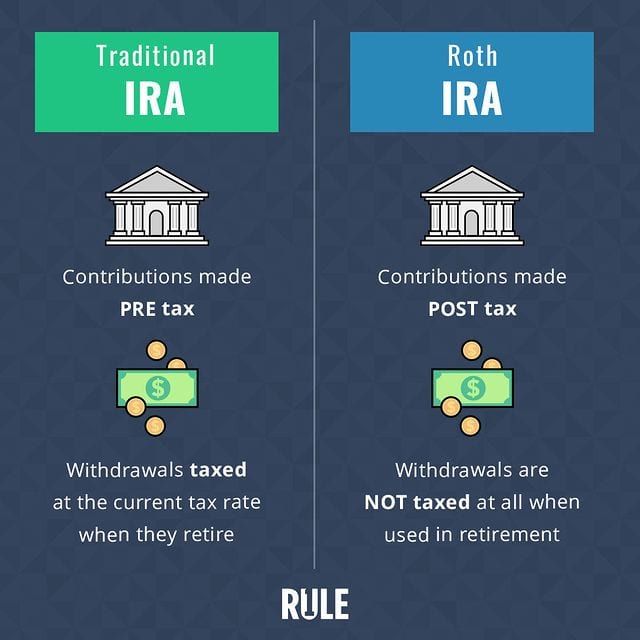People haven’t been saving for retirement for all that long. And if they were, they weren’t using Individual Retirement Accounts (IRAs) to do so.
Before IRAs came along in the 1970s, people relied on pension plans and Social Security to fund their retirement. But pension plans have become far less common and many people can’t live off of social security alone.
Congress established traditional IRAs in 1974 and Roth IRAs in 1998 to incentivize people to save for retirement on their own by offering tax advantages on contributions to these types of accounts. Both types are great vehicles to save and invest in, but there are some key differences in IRAs to note.
Let’s compare and contrast an IRA vs Roth IRA so you can pick the retirement fund that is best for you.
If you aren’t saving for retirement, you will likely struggle to maintain your lifestyle later in life to create and sustain generational wealth for your family.

What is a Traditional IRA?
A traditional IRA was the first type of account that allowed an individual to save for retirement on their own, not through their employer.
It’s an investment account where you can contribute and invest a certain amount of your earned income each year, specifically for retirement. Unlike money market accounts, these funds are untouchable (without penalty) until you reach the age of 59 and ½.
How Does a Traditional IRA Work?
With a traditional IRA, the account owner (that’s you), contributes a set amount of funds with each paycheck. These funds are routed from your employer to your IRA account before your income is taxed, making them “pre-tax” contributions. You can then invest those contributions however you like.
Once you reach the age of 59½, you can start withdrawing funds from your IRA. At this point, your withdrawals are taxed at your regular income tax rate.
There are a few other IRA rules, such as, you can contribute a maximum amount per year, which is $6,000 for individuals under age 50 and $7,000 if you’re 50 or older.
You also have to start taking a minimum required distribution (withdrawal) from your retirement account starting at age 72.
Benefits of a Traditional IRA
The biggest benefits of a traditional IRA are that you can contribute pre-tax dollars, which means you have more money invested that has the potential to compound interest and grow.

You won’t be taxed on this money until you reach retirement when you might be in a lower income tax bracket.
If you don’t have other retirement savings options through your employer, such as a pension or 401k, or your income is below a certain amount, you can also deduct your contributions to your IRA from your annual income, which could reduce your tax burden.
These tax incentives are helpful, but an advantage an IRA offers over a 401k or an employer-sponsored pension plan is the control it gives you over how the funds are invested.
As Rule #1 Investors, we don’t believe someone else can invest your money better than you can. When you’re in charge, you can invest strategically—not in a way that simply matches the market. Ultimately, this helps maximize your potential return and minimize your risk.
How to Open an IRA
You can open an IRA with any bank or broker. You may already have a brokerage account with Fidelity, Schwabb, or Merryl Lynch, for instance. If so, simply open an IRA via your current account. If you don’t have a brokerage account yet, choose a reputable company that resonates with you and open one today.
What is a Roth IRA?
A Roth IRA is similar to a traditional IRA in many ways, i.e., it’s an investment account for designated retirement funds. And while the Roth IRA still provides tax advantages, it does so in a very different way—later on, during retirement as opposed to at the time of contribution.

How Does a Roth IRA Work?
With a Roth IRA, account owners contribute after-tax dollars, and thus, can take tax-free withdrawals in retirement. So, you don’t get a tax deduction when you make a contribution to a Roth IRA.
Like IRAs, Roth accounts have rules too. Individuals under 50 can also only contribute $6,000 per year and people 50 and older can contribute $7,000. Unlike IRAs, distributions aren’t required—the account can be passed on after the owner’s death.
Another important rule with Roth IRAs that doesn’t apply to traditional IRAs is that you can’t contribute to a Roth IRA if you exceed the income limits. For example, in 2022, the income limits are:
- $204,000, if married filing jointly
- $129,000, if single, head of household, or married filing separately
If you make less than $214,000, married filing jointly, or less than $144,000, single, head of household, or married filing separately, you can still contribute to a Roth IRA but only a reduced amount.
This is a big hurdle for high-earners, which is why “backdoor Roth IRAs” have become more popular. To use a backdoor Roth IRA, the high earner contributes to a traditional IRA and then converts the traditional IRA to a Roth IRA. The funds in the IRA are taxed as ordinary income at the point of conversion.
Benefits of a Roth IRA
Similar to a traditional IRA, one of the biggest benefits of a Roth IRA for retirement savings is the control it allows you to have over your investments. After contributing to your account, you can invest the funds as you please.
But there are other benefits as well.
One big benefit is that your investments grow tax-free! So, when you withdraw funds during retirement, you aren’t taxed. This is one of the only ways to avoid capital gains tax, which can eat into the returns you earn on your investments.
How to Open a Roth IRA
You can open a Roth IRA in the same way that you open a traditional IRA. Visit a bank or brokerage and open a designated Roth IRA account. Then, you can begin making contributions.
IRA vs Roth IRA: Which One is Right for You?
In the most straightforward sense, both a traditional IRA and a Roth IRA are great investment accounts. You contribute cash, choose how you want to invest that cash, and watch it grow over time. And both types of accounts allow you to use the Rule #1 strategy to build wealth.
So, which one is right for you?

Can You Contribute to Both a Roth IRA and Traditional IRA?
Yes, you can contribute to both a Roth and traditional IRA as long as you qualify for both and don’t exceed the maximum contribution limit ($6,000 or $7,000) in combined contributions.
However, it’s a better idea to select the retirement fund that suits your financial situation best and stick with it.
How Do You Decide Between Roth and Traditional IRA?
One critical difference between traditional IRA and Roth IRA accounts is how they are taxed. This difference is typically why people choose one over the other. Here’s how to choose between a Roth and a traditional IRA based on taxation:
If you think you will be in a higher tax bracket when you retire than you are now, it benefits you to pay taxes on your retirement funds now rather than later. If you think you will be in a lower tax bracket when you retire than you are now, then the opposite is true and a traditional IRA could be right for you if you need that tax deduction now.
Remember, even if you are “retired,” your income from other investments could count toward your annual income and push you into a higher tax bracket. If this is the case, a Roth IRA would be the better choice.
Should You Convert a Roth IRA? When Does it Make Sense?
If you already have a traditional IRA, but you think a Roth IRA is the right move for you instead, you can convert a traditional IRA to a Roth IRA.
This makes sense during a year in which you face low tax rates. If you convert at this time, you could end up paying fewer taxes on your IRA funds than you would in the future.
Set Yourself Up for Retirement
Both traditional and Roth IRAs offer tax incentives and are investment vehicles that can help you save for retirement.
Still, according to a 2017 census, nearly half of adults ages 55 to 66 had no personal retirement savings. Zero! Don’t let that be you. The earlier you start saving for retirement, the more time you give compound interest to work. And the more you invest now, the less you’ll have to worry about it later.
If you’re ready to open a retirement account, or you already have a retirement account but don’t know what to do with it now, learn how to invest today and start growing your wealth!
And while you’re at it, take this Retirement Quiz to see where your finances are at and determine how prepared you are for retirement.
When you know how to make smart investments with your retirement savings, you can watch your wealth grow and be confident that your retirement is secure.

Phil Town is an investment advisor, hedge fund manager, 3x NY Times Best-Selling Author, ex-Grand Canyon river guide, and former Lieutenant in the US Army Special Forces. He and his wife, Melissa, share a passion for horses, polo, and eventing. Phil’s goal is to help you learn how to invest and achieve financial independence.